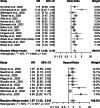Association of frailty with outcomes in individuals with COVID-19: A living review and meta-analysis
- PMID: 34048599
- PMCID: PMC8242611
- DOI: 10.1111/jgs.17299
Association of frailty with outcomes in individuals with COVID-19: A living review and meta-analysis
Abstract
Background and objectives: Frailty leaves older adults vulnerable to adverse health outcomes. Frailty assessment is recommended by multiple COVID-19 guidelines to inform care and resource allocation. We aimed to identify, describe, and synthesize studies reporting the association of frailty with outcomes (informed by the Institute for Healthcare Improvement's Triple Aim [health, resource use, and experience]) in individuals with COVID-19.
Design: Systematic review and meta-analysis.
Setting: Studies reporting associations between frailty and outcomes in the setting of COVID-19 diagnosis.
Participants: Adults with COVID-19.
Measurements: Following review of titles, abstracts and full text, we included 52 studies that contained 118,373 participants with COVID-19. Risk of bias was assessed using the Quality in Prognostic studies tool. Our primary outcome was mortality, secondary outcomes included delirium, intensive care unit admission, need for ventilation and discharge location. Where appropriate, random-effects meta-analysis was used to pool adjusted and unadjusted effect measures by frailty instrument.
Results: The Clinical Frailty Scale (CFS) was the most used frailty instrument. Mortality was reported in 37 studies. After confounder adjustment, frailty identified using the CFS was significantly associated with mortality in COVID-19 positive patients (odds ratio 1.79, 95% confidence interval [CI] 1.49-2.14; hazard ratio 1.87, 95% CI 1.33-2.61). On an unadjusted basis, frailty identified using the CFS was significantly associated with increased odds of delirium and reduced odds of intensive care unit admission. Results were generally consistent using other frailty instruments. Patient-reported, cost and experience outcomes were rarely reported.
Conclusion: Frailty is associated with a substantial increase in mortality risk in COVID-19 patients, even after adjustment. Delirium risk is also increased. Frailty assessment may help to guide prognosis and individualized care planning, but data relating frailty status to patient-reported outcomes are urgently needed to provide a more comprehensive overview of outcomes relevant to older adults.
Keywords: COVID-19; frailty; living review; outcomes.
© 2021 The American Geriatrics Society.
Conflict of interest statement
The authors report no relevant conflicts of interest.
Figures



References
-
- Ma C, Gu J, Hou P, et al. Incidence, clinical characteristics and prognostic factor of patients with COVID‐19: a systematic review and meta‐analysis. medRxiv. 2020;1‐22.
Publication types
MeSH terms
LinkOut - more resources
Full Text Sources
Other Literature Sources
Medical

